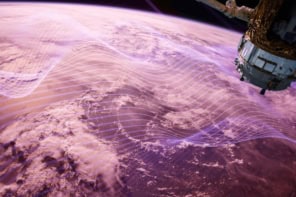
The cooling effect of aerosols in the stratosphere must be accounted for properly by computer models of Earth’s climate, say climate scientists in the US who have modelled how tiny particles in the stratosphere contribute to the planet’s heat balance. Otherwise, models will overestimate future global warming, assuming that the background concentration of these aerosols remains at least as high as it is at present.
It is well known that stratospheric aerosols cool the surface of the Earth by reflecting some of the Sun’s energy back into space. These are tiny solid or liquid particles suspended within the air and can include sea salt and dust, as well as sulphur dioxide given off by volcanic explosions or the burning of fossil fuels.
The concentration of stratospheric aerosols can rise enormously in the aftermath of major volcanic events, and this can lead to a notable drop in global temperatures. However, recent data show that the quantities of aerosols in the stratosphere can vary significantly even in the absence of major eruptions, particularly owing to the effects of moderate eruptions and probably also because of human activities.
Focusing on the background
The latest research, carried out by Susan Solomon of the National Oceanic and Atmospheric Administration’s Earth System Research Laboratory in Boulder, Colorado, and colleagues, focuses on this “background” level of aerosols and takes advantage of the fact that there have been no major eruptions, which obscure the background, since that of Mount Pinatubo in 1991.
Solomon and co-workers took data from a number of sources, including ground- and laser-based measurements recorded at the Mauna Loa volcano in Hawaii, as well as satellite observations. The satellite data reveal that stratospheric aerosols increased by about 7% a year between 2000 and 2010. This implies a change in the Earth’s radiative forcing – a measure of the imbalance between the Earth’s incoming and outgoing energy – of about –0.1 Wm–2. As the researchers point out, this compares to an annual change in atmospheric carbon dioxide of about 0.5% a year and an overall increase in radiative forcing over the last decade of +0.28 Wm–2, making the contribution of the aerosols small but “significant”.
To calculate the effect of this negative forcing on temperatures, Solomon’s group used the Bern 2.5cc climate model. This is not as complex as the “general circulation” models used to compute the overall climate but is, they say, better for investigating small temperature changes that might otherwise be hidden by the larger climate trends. They found that the stratospheric aerosols reduced warming over about the last decade by 0.07 °C, or 20%. This is when compared to a scenario with no aerosols, which is the assumption made by many models. They also calculated, based on more limited balloon data, that the presence of background aerosols reduced warming by about –0.05 °C between 1960 and 2000.
Flattening temperature rise
One of Solomon’s colleagues, John Daniel of the Earth System Research Laboratory, says that the group was motivated to model this cooling effect by a recent flattening out of the global temperature rise, although he cautions that this rise appears to be quite short term. As previously highlighted by NASA’s James Hansen, who was not involved in the current research, the flattening is present when temperatures are averaged out over periods of five years, but not when the average is taken across the whole of the 2000 to 2010 decade.
Daniel, however, emphasizes that whether or not there has been a real flattening of late is essentially irrelevant to the conclusion of the latest paper – that background levels of stratospheric aerosols must be taken into consideration in future climate projections. The researchers say that any climate models that neglect changes to these levels relative to the year 2000 are likely to overestimate warming if aerosol concentrations remain constant or continue to increase. On the other hand, they say, if concentrations were instead to drop back down to the levels last seen in 1960 then global average temperatures will be around 0.06 °C higher by 2020 than they would otherwise have been.
Predicting how these concentrations will in fact evolve is currently not possible, given our inability to predict volcanic eruptions and the large uncertainties that exist regarding future emissions of manmade sulphur dioxide, as well as our still limited understanding of how such emissions contribute to the total background. Daniel points out that if manmade emissions are a significant factor, then increasing sulphur-dioxide emissions could to some extent put a brake on warming. In any case, he points out, the relative importance of these different sources is currently being studied by a number of different research groups and should, he says, probably be much better understood within a couple of years.
Too small to matter?
Steven Sherwood of the University of New South Wales in Australia describes trends in stratospheric aerosol concentrations as “interesting and potentially important” in determining future climate, but he points out that these background levels are small compared to those associated with major volcanic eruptions and he believes that they have little to do with the “modest weakening” of global temperature trends since 2000.
Gavin Schmidt of NASA’s Goddard Institute for Space Studies in New York agrees that any effect is likely to be small compared to that from large volcanoes and intrinsic climate variability such as El Niño events and also emphasizes the difficulty of incorporating the contribution of volcanic aerosols into future climate projections. “We can either assume no volcanoes, or make some scenario based on the 20th century or on a random number generator, “he says. “Both have been tried, but neither is satisfactory because the real world volcanoes are not going to cooperate!”
The research is described in Science 10.1126/science.1206027.



